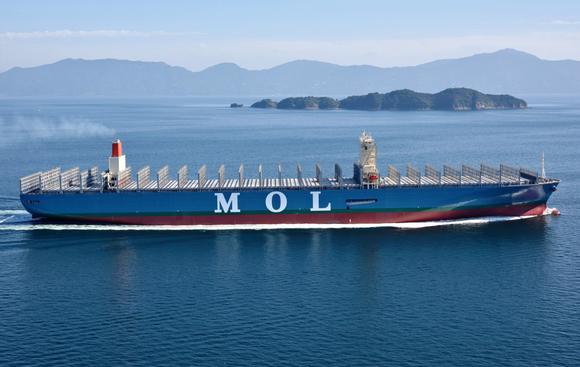Shippers increasingly are fielding immense vessels to cut the costs of transporting goods from Asia to Europe, but some fear the trend will keep freight rates at low depths.
“Large vessels will provide substantial cost benefits,” Junichiro Ikeda, president of Mitsui O.S.K. Lines, said at a naming ceremony last month for the MOL Truth, the company’s fifth containership capable of holding 20,000 twenty-foot equivalent units. Its first 20,000 TEU containership was commissioned this spring, Nikkei reported.
Enhanced engine performance and more cargo per trip will slash costs for the Japanese shipper. Fuel efficiency per container is seen rising nearly 30% compared with Mitsui O.S.K.’s mainstay 14,000 TEU containerships.
But ill effects are appearing when viewed on an industry-wide basis. The 11 commissioned 20,000 TEU ships as of October are forecast to become 70 by 2020, the Japan Maritime Center says, and all likely will be devoted to long-distance routes from Asia to Europe. In September, France’s CMA CGM confirmed an order for a 22,000 TEU vessel, as shippers worldwide bulk up their crafts.
The supply-demand balance is crumbling as shippers compete on vessel size. Global capacity climbed 31% in the five years through 2016, shipper Nippon Yusen says, while cargo volume grew just 17%.
The capacity glut sparked last year’s historic shipping struggles. Combined with a slowdown in the movement of goods, spot rates for Asia-Europe freight in March were nearly $200 per 20-foot container, one-third of the price from the year-earlier period. The slump also triggered industry consolidation, such as the bankruptcy of South Korea’s Hanjin Shipping.
“Integration is reducing the number of players,” Ikeda said. “The market will not collapse from 20,000 TEU ships.”
Such mergers and acquisitions are accelerating. Mitsui O.S.K., Nippon Yusen and Japanese compatriot Kawasaki Kisen Kaisha will integrate operations as Ocean Network Express beginning in April.
Integration will help shippers reduce service during the offseason and take other measures to maintain freight rates. But “even without similar price battles as in the past, raising rates substantially will become difficult as vessels grow more massive,” said an official from a major Asian shipper.
The impact will spread beyond European routes. As vessels get larger, the previous generation of ships are reassigned to North American and Asian routes. This means the ships servicing each route continually become bigger, one reason that freight rates for European and North American routes are trending downward despite cargo volume growing at a record pace this year.


